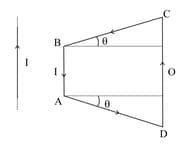Embibe Experts Solutions for Chapter: Moving Charges and Magnetism, Exercise 1: Exercise
Embibe Experts Physics Solutions for Exercise - Embibe Experts Solutions for Chapter: Moving Charges and Magnetism, Exercise 1: Exercise
Attempt the free practice questions on Chapter 19: Moving Charges and Magnetism, Exercise 1: Exercise with hints and solutions to strengthen your understanding. Achieve Indian Airforce Agniveer Vayu Physics Practice Book solutions are prepared by Experienced Embibe Experts.
Questions from Embibe Experts Solutions for Chapter: Moving Charges and Magnetism, Exercise 1: Exercise with Hints & Solutions
A particle of specific charge (q/m) is projected from the origin of coordinates with initial velocity [ui-vj]. Uniform electric magnetic fields exist in the region along the +y direction, of magnitude E and B. The particle will definitely return to the origin once if
According to Bio-Savart law states that the magnetic field due to the current element:
Assertion: Ampere's circuital law holds for steady currents which do not fluctuate with time.
Reason: Ampere's circuital law is similar to that of Biot-Savart law.
A toroid has turns per unit length. If it carries a current of , the magnetic energy density inside the toroid is
When the number of turns in a toroidal coil is doubled, then the value of magnetic flux density will becomes
Two long parallel wires separated by a distance have equal currents flowing in each. Either wire experiences a magnetic force . If the distance is increased to and current in each wire is reduced to , the force between them will now be -
Loop and long straight wire are in the same plane. Side . Distance between long straight wire and is equal to the distance between and . Net force on the loop is

A galvanometer has a coil of resistance and requires for full-scale deflection. The shunt resistance needed to convert the galvanometer into an ammeter of the range is
